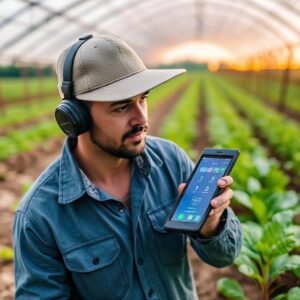Smart Farming Devices: Revolutionizing Agriculture with Technology
Introduction
Agriculture has been the backbone of human civilization for thousands of years. Today, with the growing global population and climate challenges, farmers need smarter ways to increase productivity while conserving resources. Smart farming devices are transforming traditional agriculture by integrating technology like IoT (Internet of Things), AI (Artificial Intelligence), drones, and sensors. These innovations help farmers monitor crops, optimize water usage, and reduce waste—making farming more efficient and sustainable.
In this article, we will explore the latest smart farming technologies, how they work, and their benefits for modern agriculture.

What is Smart Farming?
Smart farming, also known as precision agriculture, uses advanced technologies to monitor and manage farming operations. Instead of relying on guesswork, farmers use data-driven insights to make better decisions.
Key Technologies in Smart Farming:
-
IoT Sensors – Measure soil moisture, temperature, and nutrient levels.
-
Drones & Satellites – Provide aerial imaging for crop health analysis.
-
AI & Machine Learning – Predict crop diseases and optimize yields.
-
Automated Irrigation Systems – Save water by delivering precise amounts.
-
Robotic Harvesters – Reduce labor costs and improve efficiency.
Top Smart Farming Devices Revolutionizing Agriculture
1. Soil Moisture Sensors
How it works: These sensors are placed in the soil to measure water levels and send real-time data to farmers via mobile apps.
Benefits:
-
Prevents over or under-watering.
-
Saves water and reduces costs.
-
Improves crop health.
2. Weather Tracking Stations
How it works: Small weather stations placed in fields collect data on rainfall, humidity, wind speed, and temperature.
Benefits:
-
Helps farmers plan irrigation and planting schedules.
-
Reduces risks from extreme weather.
3. Drones for Crop Monitoring
How it works: Drones with high-resolution cameras and multispectral sensors fly over fields, capturing detailed images of crops.
Benefits:
-
Detects pests, diseases, and nutrient deficiencies early.
-
Maps fields for better resource management.
4. Smart Irrigation Systems
How it works: AI-powered systems analyze soil and weather data to automate watering schedules.
Benefits:
-
Reduces water waste by up to 30%.
-
Ensures crops get the right amount of water.
5. Livestock Tracking Wearables
How it works: GPS and biometric sensors attached to animals monitor their health, location, and activity levels.
Benefits:
-
Early detection of diseases.
-
Improves breeding and feeding efficiency.
6. Autonomous Tractors & Robots
How it works: Self-driving tractors and robotic harvesters use AI and GPS to plow, plant, and harvest crops.
Benefits:
-
Reduces labor costs.
-
Increases precision in farming tasks.
7. AI-Powered Pest Detection Apps
How it works: Farmers take photos of crops, and AI identifies pests or diseases, suggesting treatments.
Benefits:
-
Early pest control prevents crop loss.
-
Reduces unnecessary pesticide use.
Advantages of Smart Farming
-
Higher Crop Yields – Data-driven farming improves productivity.
-
Resource Efficiency – Saves water, fertilizers, and energy.
-
Cost Reduction – Lowers labor and operational expenses.
-
Sustainability – Reduces chemical use and environmental impact.
-
Real-Time Monitoring – Farmers get instant updates on their smartphones.
Challenges of Smart Farming
Despite its benefits, smart farming faces some hurdles:
-
High Initial Costs – Advanced devices require investment.
-
Internet Connectivity – Rural areas may lack strong networks.
-
Technical Knowledge – Farmers need training to use new tech.
The Future of Smart Farming
As technology advances, smart farming will become more accessible. Innovations like blockchain for food traceability, vertical farming, and AI-driven predictive analytics will further revolutionize agriculture. Governments and private sectors must support farmers in adopting these technologies for a sustainable future.
Conclusion
Smart farming devices are reshaping agriculture by making it more efficient, sustainable, and profitable. From soil sensors to AI-powered drones, these technologies help farmers grow more food with fewer resources. While challenges exist, the benefits far outweigh them, paving the way for a smarter, greener farming future.
By embracing smart farming, we can ensure food security, protect the environment, and support farmers in feeding the world.
FAQs
Q1: What is the best smart farming device for small farmers?
A: Soil moisture sensors and weather stations are affordable and highly effective for small-scale farmers.
Q2: Are smart farming devices expensive?
A: While some devices have high upfront costs, many affordable options provide significant long-term savings.
Q3: Can smart farming work in developing countries?
A: Yes, with government support and training, farmers in developing nations can benefit from cost-effective smart farming solutions.
Q4: How does AI help in smart farming?
A: AI analyzes data from sensors and drones to predict crop diseases, optimize irrigation, and improve yields.
1 thought on “Smart Farming Devices: Revolutionizing Agriculture with Technology”